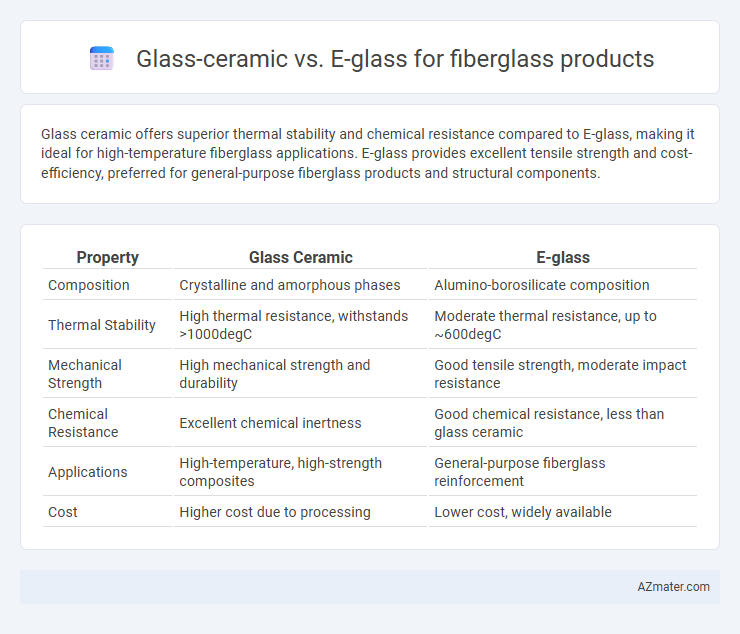Glass ceramic offers superior thermal stability and chemical resistance compared to E-glass, making it ideal for high-temperature fiberglass applications. E-glass provides excellent tensile strength and cost-efficiency, preferred for general-purpose fiberglass products and structural components.
Table of Comparison
| Property | Glass Ceramic | E-glass |
|---|---|---|
| Composition | Crystalline and amorphous phases | Alumino-borosilicate composition |
| Thermal Stability | High thermal resistance, withstands >1000degC | Moderate thermal resistance, up to ~600degC |
| Mechanical Strength | High mechanical strength and durability | Good tensile strength, moderate impact resistance |
| Chemical Resistance | Excellent chemical inertness | Good chemical resistance, less than glass ceramic |
| Applications | High-temperature, high-strength composites | General-purpose fiberglass reinforcement |
| Cost | Higher cost due to processing | Lower cost, widely available |
Introduction: Understanding Glass Ceramic and E-glass
Glass ceramic materials exhibit exceptional thermal stability and mechanical strength due to their unique crystalline microstructure, making them suitable for high-performance fiberglass applications. E-glass fibers, primarily composed of alumina-calcium-borosilicate, offer excellent electrical insulation, high tensile strength, and cost-effective reinforcement in composite materials. Both materials are integral to fiberglass manufacturing, with glass ceramics favored for heat resistance and E-glass preferred for versatility and electrical properties.
Composition and Manufacturing Process
Glass ceramic materials consist primarily of both crystalline and amorphous phases, formed by controlled crystallization of certain glass compositions, whereas E-glass fiber is made from alumino-borosilicate glass with specific oxides like silica, alumina, and boron oxide to optimize electrical insulation and mechanical strength. The manufacturing process of glass ceramics involves melting raw materials followed by precise heat treatment cycles to induce nucleation and growth of crystalline phases, contrasting with E-glass fibers produced through melting and rapid fiberizing by drawing molten glass through fine orifices to create continuous filaments. These compositional and process differences result in glass ceramics exhibiting superior thermal stability and mechanical properties tailored for high-performance applications, while E-glass fibers balance cost-effectiveness and excellent mechanical performance for broad fiberglass uses.
Mechanical Properties Comparison
Glass ceramic fibers exhibit superior mechanical properties compared to E-glass fibers, including higher tensile strength and enhanced thermal stability, making them ideal for high-performance applications. E-glass fibers offer good strength and cost-effectiveness but typically have lower modulus and reduced resistance to thermal degradation. The enhanced stiffness and durability of glass ceramic fibers provide improved resistance to mechanical stress and thermal cycling in demanding environments.
Thermal Resistance and Stability
Glass ceramics exhibit superior thermal resistance and stability compared to E-glass fibers, maintaining structural integrity at temperatures exceeding 700degC, while E-glass typically withstands up to 540degC. The crystalline phases within glass ceramics provide enhanced resistance to thermal shock and deformation, making them ideal for high-temperature applications. In contrast, E-glass fibers are more susceptible to thermal degradation and dimensional changes under prolonged heat exposure.
Electrical Insulation Capabilities
Glass ceramic fibers exhibit superior electrical insulation capabilities compared to E-glass fibers due to their enhanced thermal stability and resistance to electrical breakdown under high voltage conditions. The microstructure of glass ceramic materials offers lower dielectric constant and higher resistivity, making them ideal for high-performance insulating applications. E-glass fibers, while cost-effective and versatile, have comparatively lower dielectric strength and are less effective in environments with extreme electrical stress.
Chemical Resistance and Durability
Glass ceramic fibers exhibit superior chemical resistance compared to E-glass fibers, effectively withstanding acidic and alkaline environments commonly encountered in industrial applications. Their enhanced durability results from a robust microstructure that maintains integrity under thermal cycling and mechanical stress, outperforming the more chemically susceptible E-glass. This combination of chemical resistance and long-term durability makes glass ceramic fibers ideal for demanding fiberglass products exposed to harsh conditions.
Performance in Structural Applications
Glass ceramic fibers offer superior thermal stability and enhanced mechanical strength compared to E-glass fibers, making them ideal for high-performance structural applications that require resistance to extreme temperatures and mechanical stress. E-glass fibers provide good tensile strength and cost-effectiveness but exhibit lower resistance to heat and chemical degradation, limiting their use in environments with harsh conditions. Structural components in aerospace, automotive, and construction industries benefit from glass ceramic fibers due to their ability to maintain integrity and performance under elevated temperatures and dynamic loads.
Cost and Availability
Glass ceramic fibers generally have higher costs due to their advanced thermal and mechanical properties, making them less common in bulk manufacturing compared to E-glass fibers. E-glass fibers dominate the fiberglass market because of their affordability and widespread availability, providing a cost-effective solution for diverse industrial applications. Supply chains prioritize E-glass for standard fiberglass products, while glass ceramic fibers are reserved for specialized, high-performance needs with limited production scale.
Environmental Impact and Sustainability
Glass ceramic fibers offer enhanced durability and thermal stability compared to E-glass, leading to longer product lifespans and reduced waste. E-glass fibers, while widely used and cost-effective, generally require more frequent replacement, increasing environmental burden through higher resource consumption. The manufacturing of glass ceramic fibers typically involves higher energy inputs but results in materials better suited for recycling, improving overall sustainability profiles.
Choosing the Right Material for Fiberglass Products
Glass ceramic offers superior thermal resistance and dimensional stability compared to E-glass, making it ideal for high-temperature fiberglass applications requiring durability and minimal thermal expansion. E-glass excels in electrical insulation, corrosion resistance, and cost-effectiveness, commonly used in structural and general-purpose fiberglass products. Selecting the right material depends on balancing performance needs such as thermal endurance and mechanical strength with budget constraints and specific application environments.

Infographic: Glass ceramic vs E-glass for Fiber glass product
 azmater.com
azmater.com